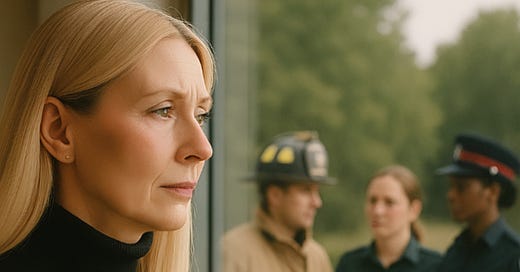From Separation to Solidarity: A New Lens on First Responder Support
Suzz Sandalwood | An exploration of how identity-based wellness models may reinforce fragmentation, and why integration may offer a more humane path forward.
Written by Suzz Sandalwood | Seeking Veritas Columnist | | Sankarsingh-Gonsalves Productions
I have a confession to make.
When I first came up with the idea for this article last week I planned to talk about how the wellness needs of each first responder group vary, why one-size-fits-all solutions don’t always work, and how we can better tailor support to ensure everyone, no matter their role, feels seen and heard, I was still holding onto a belief I hadn’t fully examined. One that’s deeply embedded in first responder culture: that no one truly understands you except your own. That police only get police. Fire only gets fire. 911 Communication Operators speak their own language. Medics know the unspoken codes. And so on.
It’s a belief that feels true because, in many ways, it is lived and practiced that way. Each service has its own culture, rhythms, rituals, and operational realities. The jobs are different, but I am now asking myself: are the mental health needs as different as we’ve made them out to be?
What if this kind of subgrouping, this mental health-by-division model is unintentionally not helping?
Recently I read an article, From Division to Active Allyship, that outlined the Gonsalves Horizontal Integration Framework (GHIF) and my perspective has shifted. The GHIF challenges the vertical structures that have long organized our social and professional landscapes hierarchies that divide and categorize people based on perceived value. It highlights how even well-meaning efforts, like identity-based support systems, can reinforce silos and obscure common struggles. I began to see just how much old narratives and the wellness systems built around it, reflect something deeper.
In first responder wellness, we have built service specific mental health programs like police specific mental health programs, fire-specific debriefing protocols and peer support teams that stop at the edge of their own service. We do it because we believe it’s necessary and that the nuances matter. But what if this kind of subgrouping, this mental health-by-division model is unintentionally not helping?
The GHIF offers a lens that prioritizes relational equity over representational inclusion by asking us not who is in the room, but how care and resources are shared among those in it. It centers common denominators over unique identifiers, encouraging us to build support systems around shared human conditions. In first responder roles, this would mean recognizing things like burnout and moral injury as systemic risks rather than individual identity markers.
When I apply this framework to first responder culture, it becomes clear to me that every role from communication operators to firefighter to paramedic to officer is vulnerable to the same core conditions. All face exposure to trauma. All are trained to suppress their own pain. All belong to cultures that often demand stoicism and discourage help-seeking. All know what it means to feel isolated, even while surrounded by a team and at some point, have asked: “Is it just me?”
We can hold space for difference without reinforcing separation.
There is something fundamentally human within first responder roles; a through-line of grief, guilt, and grace that connects responders across services. Yet, we continue to focus on their differences as if tailoring wellness by patch color is the only way to reach them. It may serve our funding applications, or fit neatly into institutional boxes, but it doesn’t always serve the people themselves. Sometimes I wonder if we hold onto these separations because we’ve internalized the vertical logic GHIF warns against; that identity must be used to prove worthiness. That legitimacy comes from being “uniquely” harmed or “uniquely” resilient but trauma doesn’t respect silos. Neither should healing.
I’m not arguing that the distinctions between services are meaningless. They aren’t. But nuance and fragmentation are not the same. We can hold space for difference without reinforcing separation. We can design wellness programs that understand role-specific stressors without retreating into identity silos that keep responders from seeing their shared humanity.
I now believe that the more urgent task is not to separate support but to integrate it.
Maybe the real work isn’t in fine-tuning how different the needs are, but in recognizing how alike the risks are, and how first responders across roles need the same things: to be heard, to be supported, to be reminded they are still human underneath it all.
So yes, this article was originally going to be a two-part series on the distinct wellness needs of each responder group but after sitting with GHIF, I’m taking a different path. I now believe that the more urgent task is not to separate support but to integrate it. We need to build systems that don’t just accommodate difference, but dissolve the illusion that difference is all that defines us.
Next Week in 911 COMMUNITY
“Not all grief involves trauma, but all trauma involves grief.” As I continue reflecting on the importance of recognizing shared experiences across first responder roles, I want to begin shifting the conversation toward a critical topic: intensive treatment for PTSD. One often-overlooked element in trauma care is the role of grief, a component that’s rarely acknowledged in treatment planning. If we’re serious about addressing the mental health needs of first responders, we must consider how unprocessed grief complicates recovery. I’ll be exploring this further next week.
About the Author: Suzz Sandalwood is an RSW/MSW Therapist, Advanced Certified Clinical Trauma and Addiction Specialist and a Certified Grief Counsellor. She has extensive professional and lived experience in first responder, addiction, and grief communities. | Connect with the author: https://suzzsandalwood.com





